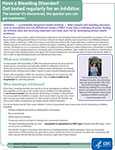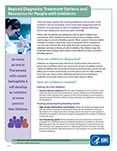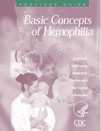Free Materials

Have a Bleeding Disorder? Get tested regularly for an inhibitor
This fact sheet talks about inhibitors, a potentially dangerous health problem that affect people with bleeding disorders.

Beyond Diagnosis: Treatment Options and Resources for People with Inhibitors
This fact sheet contains information about treatment options for inhibitors and provides resources for people have been diagnosed with an inhibitor or would like to learn more on the subject.
[English] [Spanish]

Community Counts: Fact Sheet for HTC Clinicians and Staff
This fact sheet is for HTC clinicians and staff to provide additional information on the Community Counts Registry for Bleeding Disorder Surveillance.

A component of the National Hemophilia Foundation’s (NHF’s) Steps for Living Program, funded in part by the Centers for Disease Control and Prevention, is Guidelines for Growing, a series of age-specific brochures (targeting ages 0-4, 5-8, 9-12, 13-15, and 16-18) adapted from the NHF’s Medical and Scientific Advisory Council (MASAC). Each brochure focuses on social and developmental milestones specific to the general age range of a child or young person with a bleeding disorder. This resource is designed to be used in conjunction with the HTC provider team to guide the parent or young person through transitional periods.
Guidelines for Growing Ages birth to 4 [PDF – 10.1 Mb]
Guidelines for Growing Ages 5 – 8 [PDF – 12.8 Mb]
Guidelines for Growing Ages 9-12 [PDF – 5.9 Mb]
Guidelines for Growing Ages 13-15 [PDF – 12 Mb]
Guidelines for Growing Ages 16-18 [PDF – 5.2 Mb]
Un componente del programa “Steps for Living” de la Fundación Nacional de la Hemofilia (NHF), patrocinado en parte por los Centros para el Control y la Prevención de Enfermedades, son las Guías para Crecer, una serie de folletos con información para diferentes grupos de edad (de 0 a 4, de 5 a 8, de 9 a 12, de 13 a 15 y de 16 a 18 años) adaptadas del Consejo Asesor Médico y Científico (MASAC) de la NHF. Cada folleto se enfoca en los indicadores del desarrollo y sociales específicos para cada rango de edad en niños y jóvenes con un trastorno hemorrágico. Este recurso está diseñado para usarlo en colaboración con el equipo médico del centro de tratamiento para la hemofilia (HTC) para guiar a los padres de una persona joven a través de los periodos de transición.
Guía sobre el crecimiento Las edades nacimiento-4 [PDF – 9.7 Mb]
Guía sobre el crecimiento Las edades 5-8 [PDF – 12.4 MB]
Guía sobre el crecimiento Las edades 9-12 [PDF – 28.6 Mb]
Guía sobre el crecimiento Las edades 13-15 [PDF – 11.8]
Guía sobre el crecimiento Las edades 16-18 [PDF – 21.7 Mb]

National Hemophilia Foundation
The National Hemophilia Foundation is funded by the CDC to provide information and educational materials on hemophilia for families and health care providers. They have developed several fact sheets, guides, and brochures.
National Hemophilia Foundation Information Resource Center (HANDI)

Treatment Center Brochure
This brochure is intended for payers and providers to learn about the benefits of care offered at hemophilia treatment centers and what they can do to help people with hemophilia and other bleeding disorders receive the best possible care.

This guide is written for Hemophilia Treatment Center (HTC) providers who have primary responsibility for educating families about hemophilia. It accompanies the Basic Concepts of Hemophilia: A Self-study and Planning Workbook for Families with a NewDiagnosis of Hemophilia, and it offers advice and guidance for incorporating this workbook into ongoing educational programs provided by HTC staff.

This fact sheet talks about the symptoms of bleeding disorders in women. [ English | Spanish ]

It is important to develop an emergency plan before disaster strikes. It is especially important for people with bleeding disorders to have a plan in place in order to ensure that the same level of care is maintained in the event of a disaster.

The Universal Data Collection System Fact Sheet
[ English | Spanish ]
This document provides information about recent research findings, current research projects, and future directions of the UDC System.
- Page last reviewed: February 14, 2017
- Page last updated: February 14, 2017
- Content source:


 ShareCompartir
ShareCompartir